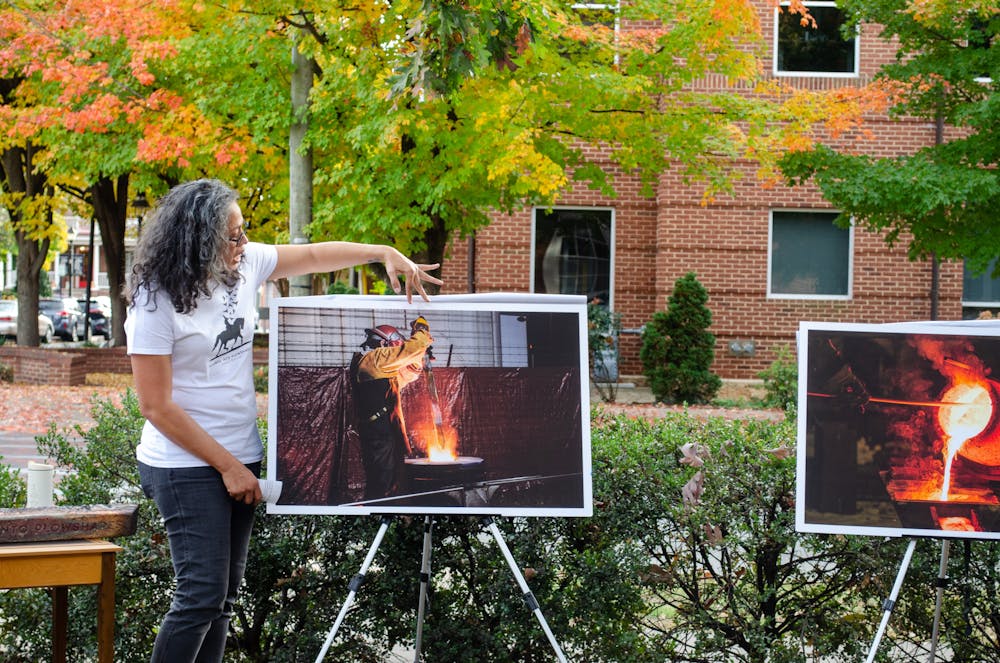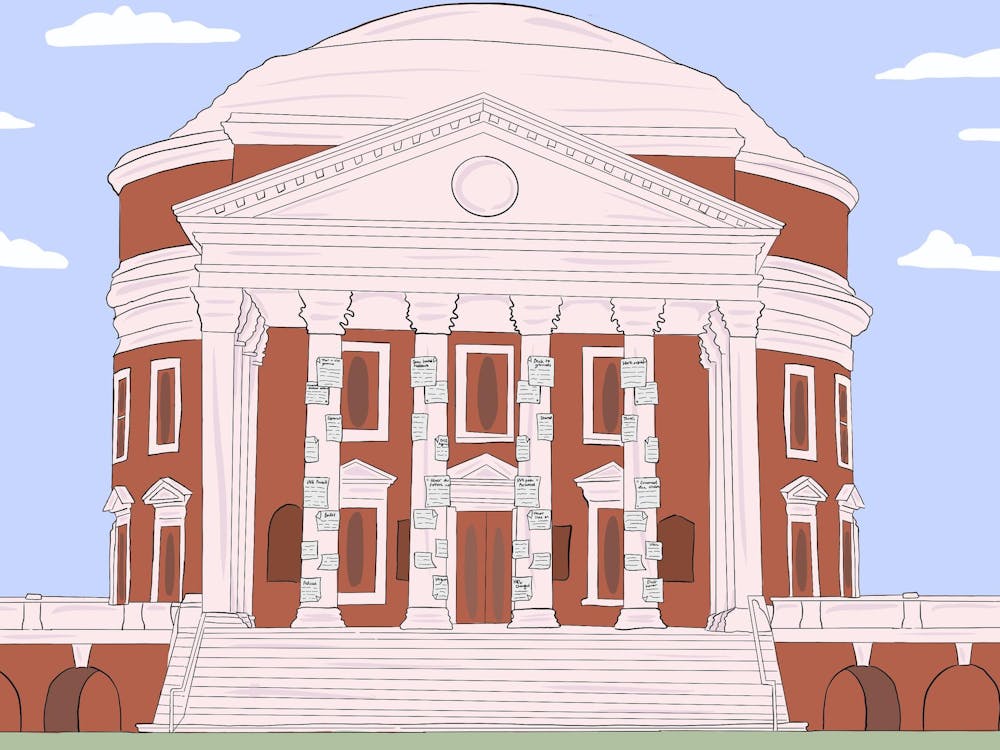When a towering crane hoisted Charlottesville’s infamous Robert E. Lee statue into the sky two years ago, onlookers caught a final glimpse of the Confederate commander and his horse. The former monument has now begun its journey back into the public eye — after melting in the heat of a 2,500 degree furnace.
Until last weekend, the statue remained tucked away in a secret storage location in the midst of ongoing legal action. While working with the City of Charlottesville to battle opposing litigation, the Jefferson School African American Heritage Center prepared for the moment it would finally transform the 6,000 pounds of bronze.
That hope ignited last Saturday. Employees at a foundry sliced apart Lee, the statue at the center of Charlottesville’s deadly “Unite the Right” rally, and dropped the metal scraps into the flaming furnace.
The statue made national headlines in August 2017 when white supremacists gathered at the University to protest the monument’s removal by brandishing torches along with racist, anti-semitic and homophobic chants. The next day’s “Unite the Right” rally turned violent. A white supremacist drove his car through a crowd of counter protestors, injuring 19 and killing Charlottesville local Heather Heyer.
More than six years later, Lee’s head and sword have transformed into an ingot reading “SWORDS INTO PLOWSHARES” — the title of JSAAHC’s project repurposing the statue into a piece of community artwork.
The group’s leaders publicly announced the update during a press conference 4:30 p.m. Thursday, a little over an hour after The Washington Post published an article detailing Lee’s demise. Event organizers unveiled blown up images from the melting process. One depicted the Confederate’s sword being thrust into the furnace. Another showed a vat of molten bronze pouring into a mold.
Prof. Jalane Schmidt, project ambassador and director of the University’s Memory Project, said through the statue’s new life, SIP leaders hope to spark national conversations on the role of monuments in public spaces.
“Swords into Plowshares is born of the conviction that we can transform white supremacist trauma into something beautiful,” Schmidt said. “This is not the end of the process. Rather, this moment marks the beginning of the next phase, which will be defined not by the struggle to remove something negative. Now we embark upon an opportunity to create something beautiful and positive.”
To assemble a new piece of community-centered art from the molten metal, SIP leaders will organize a jury to select an artist by 2024. JSAAHC executive director Andrea Douglas said the group hopes to finalize the artwork by 2027, the ten year anniversary of the “Unite the Right” rally.
“We come together this afternoon as a community to announce definitively that racist symbols do not belong in our parks, or in our city,” Douglas said.
Aiming to engage the community throughout the design process, SIP sent out surveys last year and received over 400 responses. Many community members expressed desires for the new artwork to be interactive — suggestions ranged from a public garden to a playground.
SIP will launch a community survey considering where the new piece should be installed. The group is currently fundraising for this next phase, with an estimated cost of $4 million to complete the Lee statue’s transformation.
The monumental moment follows years of litigation debating whether Charlottesville had the right to melt the Confederate statue.
In the wake of the tragic “Unite the Right” rally, the City removed the Lee statue July 2021 and donated it to JSAAHC that December. Almost immediately after, two Civil War history groups, Trevellion Battlefield and the Ratcliffe Foundation, filed suit against the City on three complaints. The trial, initially set for February 2022, faced multiple delays.
During proceedings, judge Paul Peatross removed the Ratliffe Foundation as a plaintiff after discovering the group’s corporation status expired back in 2015. Peatross later dismissed two of the three complaints against the City — leaving only one complaint over an alleged Freedom of Information Act violation.
The Trevellion Foundation then voluntarily dismissed its Freedom of Information Act claim. The court granted a nonsuit Sept. 26, with Thursday marking the expiration of the plaintiff's 30-day appeal window.
Since there was no injunction, JSAAHC could have taken the statue to the foundry at any point during the trial. JSAAHC legal counsel Chris Tate said although the suit was “frivolous,” the museum waited to melt the statue out of respect for the legal system.
“We’re grateful to the Court for its well-reasoned opinions supporting our position, and we’re happy that justice prevailed in this case,” Tate said. “Removing these symbols from our public spaces has the support of a broad swath of our community. And outside forces that fought against that removal have brought to our city some of its darkest days.”
Representatives declined to reveal where the statue was melted down or where the remaining bronze will be stored.
The bronze horseman had already been cut into nine pieces at an unspecified time before traveling to the foundry. Given past threats to the SIP project and litigation, Schmidt said melting the statue in secret was the most effective way to transform the piece in the face of opposition.
“Their goal was to put Humpty Dumpty back together again,” Schmidt said. “You know, it was public knowledge that it had been disassembled… so we wanted to do something that was just irrevocable.”
The Lee statue was erected in 1924 as a gift from Paul McIntire, philanthropist and namesake of the McIntire School of Commerce. The installment contributed to the “Lost Cause” movement popularized after the end of the Civil war — an ideology attempting to frame Southern slavery in a positive light.
Cities across the South have recently faced heightened backlash over references to the Confederate past. More than 140 Confederate monuments were removed between 2015 and 2020. Richmond took down its last Confederate statue last year.
Ongoing debates over Charlottesville’s Lee statue were reignited by a 2016 petition launched by Zyahna Bryant, local activist and graduate College student.
Douglas read a written statement from Bryant, who was unable to attend Thursday's event. Bryant said SIP’s transformation invites Charlottesville to use art as a bridge to inform its citizens about the past while also creating a hopeful future.
“What happens after we have done the work of bearing witness to the many ways that a space has been limited due to a deep and ugly history intended to be exclusionary?” Bryant wrote. “Well, we have the option to counter that with stronger and bolder action that not only includes everyone, but that specifically brings to the center those who have been pushed to the margins and edited out.”
For Charlottesville, a city whose population was majority enslaved laborers before the end of the Civil War, a community rocked by tragedy following Heyer’s death, Lee’s melting down marks an important step towards reflection.
Douglas said SIP hopes to honor the struggles of those who came before, from Black Charlottesville residents to recent progressive activists.
“Our efforts have not been to remove history but bear witness to our truths about our racist past and our aspirations,” Douglas said.
CORRECTION: A previous version of this article incorrectly stated that Jalane Schmidt read Zyahna Bryant's statement aloud. Andrea Douglas read the statement aloud. The article has been updated to reflect this change.







